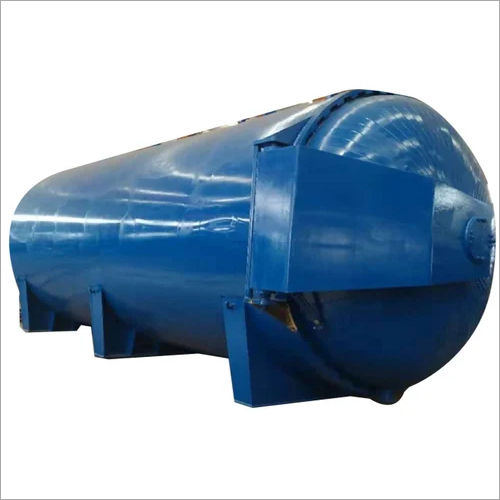Rubber Vulcanizing Autoclave
Product Details:
- Type Rubber Vulcanizing Machine
- Material Metal
- Automatic Grade Automatic
- Warranty Yes
- Click to View more
Rubber Vulcanizing Autoclave Price And Quantity
- 400000 INR/Unit
- 1 Unit
Rubber Vulcanizing Autoclave Product Specifications
- Automatic
- Rubber Vulcanizing Machine
- Yes
- Metal
Rubber Vulcanizing Autoclave Trade Information
- 10 Unit Per Month
- 30 Days
- All India
Product Description
A specialised vessel used in the rubber industry for the vulcanization process is called a rubber vulcanizing autoclave. By cross-linking the polymer chains, vulcanization is a chemical process that turns natural or synthetic rubber into a more robust and stable substance. The vulcanization process can take place because the autoclave delivers the requisite heat and pressure.
Listed below are some of the main characteristics and uses of a rubber vulcanizing autoclave:
1. Construction: An autoclave for vulcanizing rubber is typically a cylindrical container built of premium components like carbon steel or stainless steel. It is made to withstand the high temperatures and pressures necessary for vulcanization. The autoclave has a sealing device, like a door or lid, to guarantee a tight, secure closing while in use.
2. Heat and Pressure: In order to trigger the chemical reactions that cross-link the rubber molecules, vulcanization calls for high temperatures and pressure. The autoclave offers a regulated setting where pressure and heat can be applied to the rubber parts. Depending on the particular rubber composition and preferred vulcanization procedure, the temperature and pressure are carefully controlled.
3. Steam or Hot Air: The autoclave circulates steam or hot air inside the vessel to produce the necessary heat. Steam is frequently employed because it offers effective and even heating. The steam or air in the autoclave is heated by heating coils or elements, which then transfers the heat to the rubber components.
4. Autoclaves used for rubber vulcanization have accurate temperature and pressure control systems. Throughout the vulcanization process, these systems make sure that the proper temperature and pressure levels are maintained. To produce reliable and high-quality vulcanization outcomes, accurate control is crucial.
5. Autoclaves are fitted with safety safeguards to safeguard users and guarantee the equipment is operated safely. These might include interlocks to stop the autoclave from opening while it is under pressure, temperature sensors, emergency stop buttons, and pressure relief valves.
6. Process Monitoring: Monitoring systems that offer real-time data on temperature, pressure, and other pertinent parameters are frequently installed in autoclaves. This enables operators to carefully watch the vulcanization process, adjust as necessary, and guarantee that the operation is going according to plan.
7. Rubber vulcanizing autoclaves are available in a range of sizes and capacities to meet specific manufacturing needs. The size of the autoclave is determined by things like the size of the rubber components being vulcanised, the volume of production, and the amount of floor space that is available.
The manufacture of tyres, rubber gaskets, seals, conveyor belts, and other rubber products is only one of the many uses for rubber vulcanizing autoclaves in the rubber industry. They offer a regulated and effective vulcanization environment, ensuring the manufacturing of superior and long-lasting rubber products.
Other Details:
|
Capacity |
20000 Litre |
|
Material |
Mild Steel |
|
Storage Material |
Chemicals |
|
Technique |
Hot Rolled |
|
Usage/Application |
Storage |
|
Working Pressure |
200 Psi |

Price:
- 50
- 100
- 200
- 250
- 500
- 1000+
 |
DEVJOGI ENGINEERING
All Rights Reserved.(Terms of Use) Developed and Managed by Infocom Network Private Limited. |

 Send Inquiry
Send Inquiry

